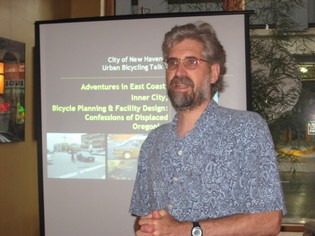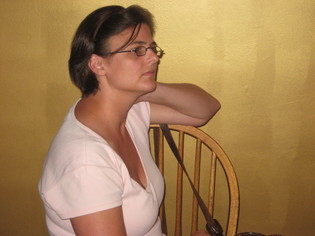 Our horse-friendly streets were ready for cyclists, but cars got in the way.
Our horse-friendly streets were ready for cyclists, but cars got in the way.
So said bicycle transportation guru Bob Patten, who spoke at a gathering at Miya’s restaurant on Howe Street Friday afternoon about how to integrate bicycles into the urban streetscape.
Patten has worked on bicycle transportation issues around Washington, D.C., for 15 years. He still considers himself a “displaced Oregonian,” having grown up in Portland, now the urban bicycling mecca of the country.
 About a dozen people (most of them his in-laws, the Wessel family, like former city transportation czar Paul and his dad Morris, pictured) sat around a long table at Miya’s as the rain poured down outside and Patten responded to the question of how to make cities like New Haven friendlier for cyclists.
About a dozen people (most of them his in-laws, the Wessel family, like former city transportation czar Paul and his dad Morris, pictured) sat around a long table at Miya’s as the rain poured down outside and Patten responded to the question of how to make cities like New Haven friendlier for cyclists.
“That’s a lot harder on the East Coast” than the West Coast, he said, because the streets have been around for hundreds of years and are usually narrower and more unforgiving than those in younger parts of the country. He added, “The roads were originally designed for horses, which are more like bikes than cars.” But over the last century motor vehicles have taken over.
Patten pointed out that perhaps the biggest impediment to more people taking up regular cycling in urban areas is the (well-placed) fear of motorized traffic. One solution: create streets that are more like off-road trails, where bicyclists can be safely separated from other traffic. But creating that connectivity depends on many factors: the level of institutional competence, personal lifestyles, differences in class and culture, and political will. (See, for instance, this story about the state transportation department’s resistance to making room for separate cycle lanes in its upcoming widening of Whalley Avenue.)
Patten said that when people talk about bicycle commuting they often mean just getting back and forth from work. That leaves out the majority of trips that urban dwellers make — to shop, to run errands and to visit friends and family. He prefers the term “utilitarian bicycling” as opposed to purely recreational or competitive cycling.
Doored Zones & “Sharrows”
In describing the minimum widths of travel lanes and bike lanes, Patten said the door zone can become a big concern. That’s the area of a bike lane where a rider can be hit by a car door as a driver opens it after parking next to the curb. Because New Haven streets are so narrow (the city has determined that only a dozen or so are wide enough to safely accommodate a bike lane), this is a major problem. For example, most of the bike lane on Orange Street is in the door zone, forcing riders to straddle the white line demarcating the bike lane from the motor vehicle lane.
Patten showed pictures of “sharrows” — markings on the road indicating that bikes can legally share the lane with cars. He said they are included in the official standards that transportation engineers use when designing roads. Some cycling advocates in New Haven have pushed for these, while others are less sure it’s the safest way to go.
Patten also described other road markings, like bike boxes. These are squares (usually of a different color than the road surface) painted at intersections to indicate that cyclists can get out front of motor vehicles at red lights, and be the first to move when the light changes.
His general message: “Road markings can have an impact.”
 Fair Haven Alderwoman Erin Sturgis-Pascale (pictured) had a busy bike-related day. In the morning she attended the August Bike to Work Day breakfast in front of City Hall, sponsored by Elm City Cycling, where she thanked cyclists for their advocacy. She said she has introduced Complete Streets legislation that the board will be taking up later this year, that takes into account the needs of pedestrians and cyclists as well as motorists.
Fair Haven Alderwoman Erin Sturgis-Pascale (pictured) had a busy bike-related day. In the morning she attended the August Bike to Work Day breakfast in front of City Hall, sponsored by Elm City Cycling, where she thanked cyclists for their advocacy. She said she has introduced Complete Streets legislation that the board will be taking up later this year, that takes into account the needs of pedestrians and cyclists as well as motorists.
At the afternoon event at Miya’s, she asked a lot of questions that indicated her expertise on the issue, having to do with road design and markings